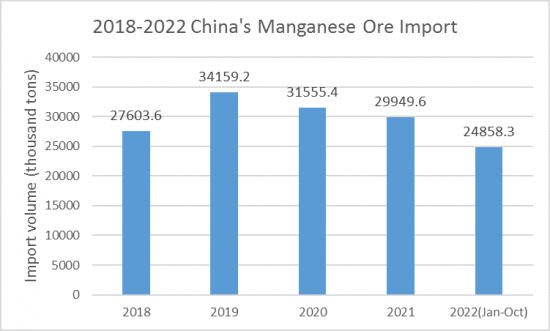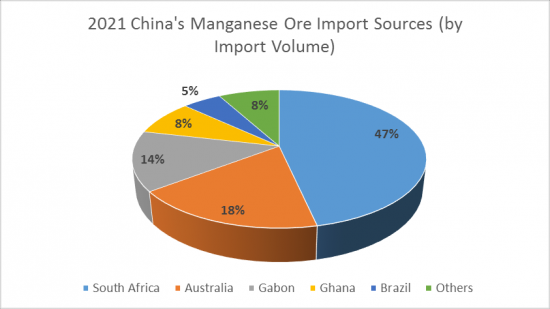 |
市場調查報告書
商品編碼
1164295
中國鉛礦進口分析(2023-2032年)Research Report on China's Lead Ore Import 2023-2032 |
||||||
鉛的主要用途是製造鉛酸電池,隨著全球汽車工業的增長,全球鉛的消耗量逐年增加。 據稱,到 2022 年底,全球道路上行駛的汽車將超過 15 億輛。 而由於鉛酸電池的使用壽命一般不到3年,全球每年都需要更換大量的鉛酸電池。 中國是世界鉛酸電池生產和出口大國,但由於國內鉛礦儲量不足,每年必須進口大量鉛礦。
示例視圖


2021年我國將進口鉛礦砂及其精礦(以下簡稱鉛礦)119.3萬噸,同比下降8.9%,進口額18.5億美元,同比增長8.5%年。)是。 2022年前三季度,我國進口鉛礦石74.9萬噸(同比下降13.4%),進口額11億美元(同比下降17.0%)。 中國鉛礦石進口減少的主要原因是由於 COVID-19 導致工廠開工減少,導致中國對鉛礦石的需求減少。 2023年至2032年,預計COVID-19對中國經濟的負面影響將消退,中國市場鉛礦需求將逐步恢復。
2018-2022年前三季度,我國鉛礦進口均價總體呈先升後降的趨勢。 2018-2020年大致穩定在1300美元/噸左右,2021年達到1551.8美元/噸(同比上漲19.0%)。 2022年前三季度,中國鉛礦石平均進口價格將降至1473.5美元/噸(同比下降4.1%)。
2021年,我國共從39個國家和地區進口鉛礦石。 據中國國際廣播電台分析,中國鉛礦進口的主要來源地(按體積計)是俄羅斯、美國、土耳其、秘魯和澳大利亞。 其中,俄羅斯是我國最大的鉛礦進口國,2021年進口鉛礦26.6萬噸(佔進口總量的22.3%),進口額達到4.4億美元(佔進口總量的23.5%)。 2021年,美國將超過秘魯成為第二大進口國,達到18.9萬噸(同比增長37.1%)。
從2023年到2032年,預計中國每年仍需要大量進口鉛礦。
在這份報告中,我們分析了中國鉛礦石進口市場,包括總體進口量和進口額、主要進口來源地(2018-2022 年)、按類型分類的詳細趨勢、進口價格趨勢,我們將匯總並發布關鍵信息市場驅動力和製約因素、主要參與者的概況和戰略,以及未來進口趨勢展望(2023-2032 年)。
內容
第一章中國鉛礦進口分析(2018-2022年)
- 中國鉛礦進口規模
- 中國鉛礦進口量
- 中國鉛礦石進口額
- 中國鉛礦進口價格
- 中國鉛礦石表觀消費量
- 中國對鉛礦石進口的依賴
- 中國主要的鉛礦進口國
- 進口量
- 進口價值
第2章中國鉛礦石進口分析(2018-2022年)
- 進口量
- 進口價值
- 進口價格
- 依賴進口
- 按類型進行進口分析
- 進口量:按類型分類
- 導入值:按類型
- 進口價格:按類型
- 主要進口商
- 進口量
- 進口價值
第3章中國鉛精礦進口分析(2018-2022)
第四章中國鉛礦主要進口來源地分析(2018-2022年)
- 從俄羅斯進口鉛礦石的分析
- 美國鉛礦進口分析
- 土耳其鉛礦進口分析
- 從秘魯進口鉛礦石的分析
- 分析從澳大利亞進口的鉛礦石
- 從其他國家/地區進口鉛礦石的分析
第5章中國鉛礦進口展望(2023-2032年)
- 影響中國鉛礦進口的因素
- 有利因素
- 不利因素
- 中國鉛礦石進口預測 (2023-2032)
- 進口量預測
- 進口量預測:按主要進口來源
- 進口量預測:按主要類型
The main use of lead is in the manufacture of lead-acid batteries, and as the global automotive industry grows, global consumption of lead is increasing year by year. According to CRI analysis, by the end of 2022, there will be more than 1.5 billion vehicles worldwide. And the service life of lead-acid batteries is generally not more than 3 years, so the world needs to replace a large number of lead-acid batteries every year. China is the world's major producer and exporter of lead-acid batteries, and because China's local lead ore reserves are insufficient, China has to import a large amount of lead ore every year.
SAMPLE VIEW


In 2021, China imported 1.193 million tons of lead ore and its concentrates (referred to as lead ore, hereinafter), down 8.9% year-on-year, and the import value was US$1.85 billion, up 8.5% year-on-year. In the first three quarters of 2022, China imported 749,000 tons of lead ore, down 13.4% year-on-year, and the import value was US$1.10 billion, down 17.0% year-on-year. The main reason for the decline in China's lead ore imports in 2021-2022 is the decline in demand for lead ore in China due to lower plant starts as a result of COVID-19. Demand for lead ore in the Chinese market is expected to recover gradually in 2023-2032 as the adverse effects of COVID-19 on the Chinese economy fade away.
In the first three quarters of 2018-2022, the average price of China's lead ore imports generally shows a trend of increasing before decreasing. According to CRI analysis, in 2018-2020, the average price of China's lead ore imports fluctuates slightly but is generally stable at around US$1300 per ton, and in 2021, the average price of China's lead ore imports rises to US$1551.8 per ton, up 19.0% y-o-y. In the first three quarters of 2022, the average price of China's lead ore imports falls to US$1473.5 per ton, down 4.1% year-on-year.
In 2021, China imported lead ore from a total of 39 countries and regions. CRI analysis shows that China's major sources of lead ore imports by import volume are the Russian Federation, the United States, Turkey, Peru and Australia. Among them, the Russian Federation is China's largest source of lead ore imports, with China importing 266,000 tons of lead ore from the Russian Federation in 2021, accounting for 22.3% of the total import volume and the import value of US$440 million, accounting for 23.5% of the total import value. In 2021, the U.S. overtook Peru as China's second largest source of lead ore imports, with the import volume reaching 189,000 tons, up 37.1% year-on-year.
CRI expects that China will still need to import large amounts of lead ore each year from 2023-2032.
Topics covered:
- China's Lead Ore Import Status and Major Sources in 2018-2022
- What is the Impact of COVID-19 on China's Lead Ore Import?
- Which Companies are the Major Players in China's Lead Ore Import Market and What are their Competitive Benchmarks?
- Key Drivers and Market Opportunities in China's Lead Ore Import
- What are the Key Drivers, Challenges, and Opportunities for China's Lead Ore Import during 2023-2032?
- What is the Expected Revenue of China's Lead Ore Import during 2023-2032?
- What are the Strategies Adopted by the Key Players in the Market to Increase Their Market Share in the Industry?
- What are the Competitive Advantages of the Major Players in China's Lead Ore Import Market?
- Which Segment of China's Lead Ore Import is Expected to Dominate the Market in 2032?
- What are the Major Adverse Factors Facing China's Lead Ore Import?
Table of Contents
1. 2018-2022 China's Lead Ore Import Analysis
- 1.1. China's Lead Ore Import Scale
- 1.1.1. China's Lead Ore Import Volume
- 1.1.2. China's Lead Ore Import Value
- 1.1.3. China's Lead Ore Import Price
- 1.1.4. China's Apparent Lead Ore Consumption
- 1.1.5. Import dependence of lead ore in China
- 1.2. Major Import Sources of Lead Ore in China
- 1.2.1. By Import Volume
- 1.2.2. By Import Value
2. China's Coarse Lead Ore Import Analysis 2018-2022
- 2.1 Coarse Lead Ore Import Volume
- 2.2. Coarse Lead Ore Import Volume
- 2.3. Coarse Lead Ore Import Price
- 2.4 Import Dependence of Coarse Lead Ore
- 2.5 Analysis of Coarse Lead Ore Import by Type
- 2.5.1 Import Volume of Coarse Lead Ore by Type
- 2.5.2. Import Value of Coarse Lead Ore by Type
- 2.5.3. Import Price of Various Types of Coarse Lead Ore
- 2.6 Sources of Coarse Lead Ore Imports
- 2.6.1. By Import Volume
- 2.6.2. By Import Value
3. 2018-2022 China Lead Ore Concentrate Import Analysis
- 3.1. Import Volume of Lead Ore Concentrate
- 3.2. Import Value of Lead Concentrate
- 3.3. Import Price of Lead Concentrate
- 3.4 Import Dependence of Lead Concentrate
- 3.5 Analysis of Import of Lead Concentrate by Type
- 3.5.1 Import Volume of Lead Concentrate by Type
- 3.5.2. Import Value of Lead Concentrate by Type
- 3.5.3. Import Price of Lead Concentrate by Type
- 3.6 Sources of Lead Concentrate Imports
- 3.6.1. By Import Volume
- 3.6.2. By Import Value
4. 2018-2022 Analysis of the Main Import Sources of Lead Ore in China
- 4.1 Analysis of Imports of Lead Ore from the Russian Federation
- 4.2. Analysis of Imports of Lead Ore from the United States
- 4.3 Analysis of Imports of Lead Ore from Turkey
- 4.4 Analysis of Imports of Lead Ore from Peru
- 4.5 Analysis of Imports of Lead Ore from Australia
- 4.6 Analysis of Imports of Lead Ore from Other Countries
5. China's Lead Ore Import Outlook 2023-2032
- 5.1 Factors Affecting China's Lead Ore Imports
- 5.1.1 Favorable Factors
- 5.1.2. Unfavorable Factors
- 5.2. China's Lead Ore Import Forecast, 2023-2032
- 5.2.1 Import Volume Forecast
- 5.2.2. Forecast of Major Import Sources
- 5.2.3. Major Imported Lead Ore Types Forecast






